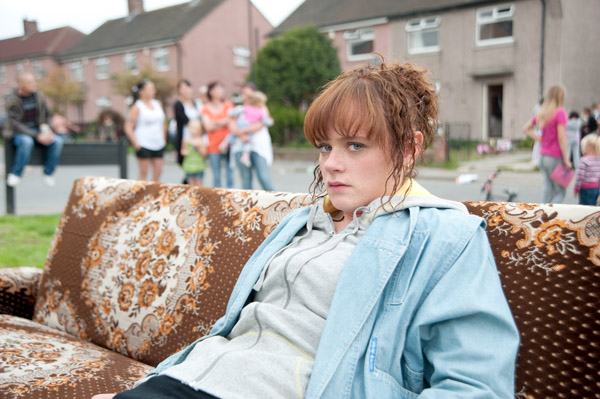|
Reviews of Recent Independent, Foreign, & Documentary Films in Theaters and DVD/Home Video

THE ARBOR
Barnard deftly draws on several streams of unusual resources to delve into the story of Andrea Dunbar and her family. First were Andrea’s own words through her three vibrant plays—The Arbor, begun as a school assignment then staged in London in 1980; Rita, Sue and Bob Too, produced in 1982 then turned into a cheeky film four years later; and Shirley (1986)—and her letters to her theatrical mentor, director Max Stafford-Clark. The straight outta Bradford, Yorkshire housing projects wunderkind brought a feisty woman’s perspective to the tradition of confrontational, alcohol-fueled British kitchen sink dramas. Hers was the tart, foul-mouthed voice of an abused girl from a large obstreperous family. Pregnant at 15, she went on to have two more children by different fathers. She is also seen and heard in the hometown-girl-made-good interviews on local television in the 1980s. The family and their
environs were updated to 2000 in Robin Soans’s play A State Affair.
Commissioned by Stafford-Clark, the “verbatim theater” piece looked back
at Dunbar’s death, at 29 in 1990, her now drug-wracked, deteriorated
neighborhood, and Andrea’s bitter daughter
Lorraine, who was 10 when her mother died, as she starts to
repeat the same vicious downward cycle. (It was compiled somewhat like
the “in their own words” work of Barnard combines these elements in audacious interpretations and juxtapositions. She eschews the exhibitionism of reality TV or the awkward intrusiveness of observational documentaries. Instead she provides some privacy by employing just the voices from her interviews in what she calls “the audio screenplay.” Actors then lip synch the interviews in reconstructed settings (much less stylized than in Errol Morris’s work). The non-judgmental portrayals are especially striking when horrific events are related matter-of-factly or when grief pours out. (Their thick Yorkshire patois is helped by subtitles.) Several of the actors have personal ties to Andrea’s work. Her sister Pamela is portrayed by Kathryn Pogson, who starred in the first production of The Arbor. Two actors were in the film of Rita, Sue and Bob Too: George Costigan, who here is Jimmy “the Wig,” the older, alcoholic, abusive father of Andrea’s youngest child; and Kulvinder Ghir, who cameos as Rafee, Lorraine’s sugar daddy. While family members recall Andrea more for staying out at pubs than staying up late to write, the autobiographical nature of her frank plays is brought home by bringing her first play home—scenes from The Arbor are staged in the projects where the Dunbar family lived. In excerpts from several scenes, local resident Natalie Gavin conversationally plays the “The Girl” with brass, eerily bringing teenage Andrea to life. (If Bradford looks familiar, it was also the setting for the Red Riding Trilogy, and that film’s serial killer is referred to as yet another threat to struggling young women there—a friend of Andrea’s was one his few surviving victims.) To emphasize the connections between fact and fiction of paternal influences, Danny Webb portrays both Stafford-Clark in interviews and “The Father” in the outdoor performance. With the players surrounded by gawking locals, “The Girl” and her cohorts comment from a sofa, moments that seems taken from the almost identical philosophizing perch in the first season of David Simon’s The Wire, an iconic profile of another urban community doomed by unemployment and drugs.
After the opening sequence that reconstructs a terrifying
episode from the lives of Andrea’s children, the focus shifts more and
more to her elder
daughter
Lorraine (portrayed by Manjinder Virk). As Lorraine
blames all her hardships—abuse, rape, drugs, prostitution, and
worse—on the mother she cannot forgive, Barnard
gradually reveals that the extensive
interviews with her are taking place in prison. Sorrowfully, the
poignant excerpts from Andrea’s plays and the interviews emphasize the
repeating patterns of choices within her family.
Playing along with the film’s theatrical debut at the
Film Forum in New York City is the rarely seen comedy Rita, Sue
and Bob Too, a lasting reminder that for a brief time Andrea Dunbar
self-confidently looked ahead to a more hopeful future through art.
Nora Lee Mandel
|

